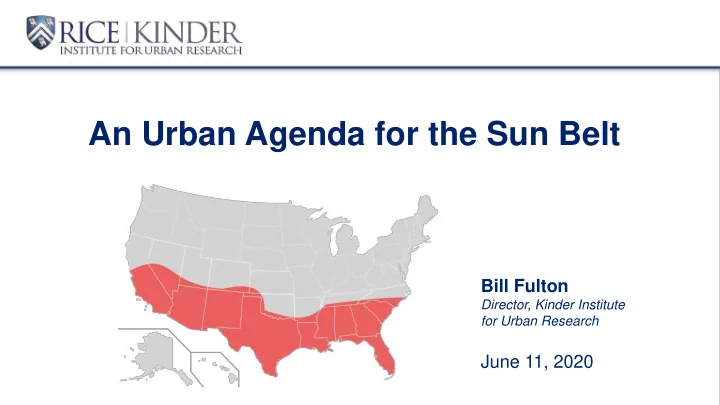

An Urban Agenda for the Sun Belt Bill Fulton Director, Kinder Institute for Urban Research June 11, 2020
Our Role • Urban research institute studying Houston and, increasingly, Texas- and Sun Belt-wide issues • Focused on education, housing, transportation, governance and resiliency
Why Take On This Issue? • The Urban Sun Belt accounts for 41% of all U.S. population growth • Most U.S. urban policy is focused on NE/MW cities • Our paper highlights the differences between Sun Belt urban areas and their counterparts elsewhere
Why Take On This Issue? • Our work today is meant to be the first word, not the last word • We don’t cover all issues • Should there be a Sun Belt urban agenda?
Large Sun Belt Metros Are … • Growing much faster than their counterparts elsewhere • Adding more younger and older residents • Adding many jobs, but mostly in the highest- and lowest- paying sectors
Large Sun Belt Metros Are … • Adding more poor residents • Losing their housing affordability advantage • More auto-dependent, therefore they have high transportation costs and relatively low public transit ridership
Defining the Sun Belt • 22 metro areas of 1 million people or more • Below the 36’30 ° parallel • These metros account for almost half of all U.S. population growth
Growing much faster
Adding more old and young
Adding Latino and Asian residents quickly
Shedding manufacturing jobs more slowly
Adding service jobs more quickly
Also shedding homeowners quickly
And adding renters quickly
Government Capacity • Government spending less per capita than elsewhere in the U.S. • Many states have no income tax, low property taxes, and high sales taxes • Local government employment has been growing faster than elsewhere
Philanthropic Capacity • Philanthropies can play a major role • Legacy cities have more capacity than newer Sun Belt cities • Some Sun Belt business centers are outliers
What Does An Urban Agenda For The Sun Belt Look Like?
Recommend
More recommend